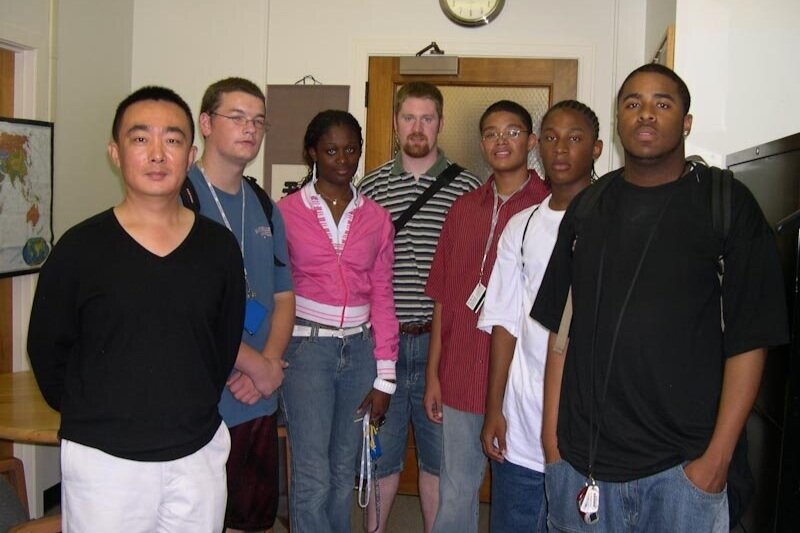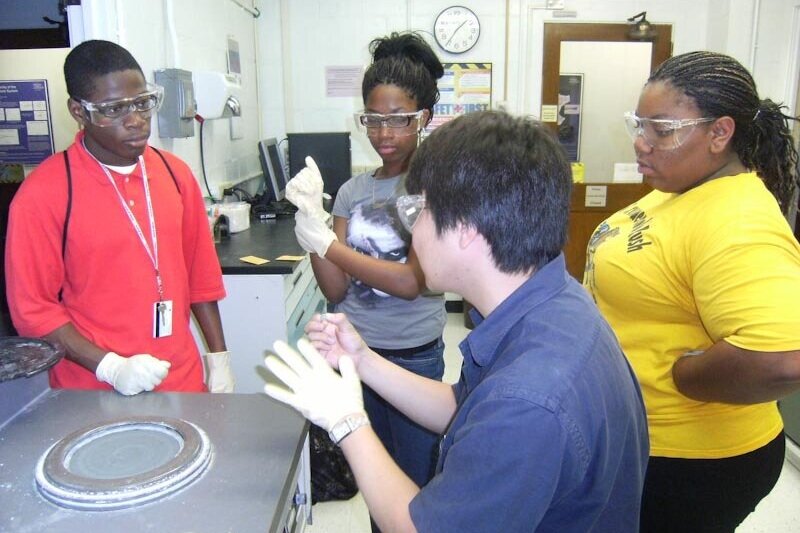SEEMS is offered to participants in the Upward Bound Math and Science (UBMS) Program, one of the federally funded TRIO Programs designed to support and motivate students from disadvantaged backgrounds. The program focuses on first-generation college students, providing academic enrichment throughout the year as well as an intensive six-week program each summer while the student is still in high school. Penn State UBMS holds a 100 percent postsecondary education acceptance rate and a 100 percent high school graduation rate for participants in the program.
Phases Research Lab has participated in the SEEMS since 2004.
Our Teams:
2004 TEAM F: Computational Thermodynamics and Kinetics: Mg-based Alloys
Our project will examine how computational thermodynamics and kinetics can be used to solve practical problems. Students will be introduced to some basic thermodynamics and kinetics knowledge and will be guided to use professional software such as Thermo-Calc and Dictra to solve real application problems. They will learn how to make diffusion couples and investigate the experimental data on solid phase equillibria and phase relationships in some binary systems or pseudo-binary systems provided by diffusion couples. They will select the initial isothermal holding temperature and time based on thermodynamic calculations (by Thermo-Calc) and phase transformation simulations (by Dictra). Metallographic samples will be prepared. A number of different methods will be used to characterize the intermediate phases presented in the diffusion couples, including optical microscopy, microhardness measurement, EPMA and X-ray diffractions. SEM, OIM, and TEM will also be used if needed. The overall goal of the program is to provide a preview of what a career in materials science and engineering might be like and the new trend of in the materials sciences research.
Student Grade School
Jamael Boynes 12 Harrisburg High School
Derrick Artis 10 William Penn High School
Lakeisha Farlow 11 Germantown-Lankenau Motivational High School
Eduardo Lipe 10 Reading High School
Joseph Mercer 10 Mahanoy Area High School
Mentor: Dr. Zhi-Jie Liu
2005 Team A: Computational Thermodynamics and Kinetics: Mg-based Alloys
Faculty: Prof. Zi-Kui Liu
Graduate Student: Yu Zhong
UBMS Instructor: Kevin Harman
Platinum-based alloys (γ-Pt / γ-Pt3Al) have been identified as potential ultra-high temperature structural alloys for hot components in jet turbine engines and rockets. Platinum is one of the most expensive metals, and also one of the densest (21.3 g/cm3). To alleviate the high cost and lower the density, the Pt is alloyed with Ni, which behaves crystallographically similar to Pt, and is the base-element in Ni-based superalloys used to manufacture jet turbine blades. Though these alloys received a lot of attention recently, there is still some uncertainty in the phase equilibria, which hinders the refinement of the thermodynamic model. In this study, we propose to prepare various diffusion couples between alloys with different compositions. The diffusion couples will be heat-treated at temperatures based on theoretic predictions to study the formation of various phases. The information obtained will provide better understanding of phase relations in Pt alloys and be used to refine the thermodynamic model for Pt alloys.
Student Grade School
Chris Hassler 11 Reading High School, PA
Ryeheim Magobet 12 William Penn High School, PA
Estrillita Olvera 12 Avon Grove High School, PA
Robert Stewart 11 Selma Early College High School, AL
Dahiana Tejada 12 Reading High School, PA
2006 Team A: Computational Thermodynamics and Kinetics: Phase Stability of Pt-based Alloys by Diffusion Couples
Faculty: Prof. Zi-Kui Liu
Graduate Student: Sara Prins
UBMS Instructor: Kevin Harman
Platinum-based alloys (γ-Pt / γ-Pt3Al) have been identified as potential ultra-high temperature structural alloys for hot components in jet turbine engines and rockets. Platinum is one of the most expensive metals, and also one of the densest (21.3 g/cm3). To alleviate the high cost and lower the density, the Pt is alloyed with Ni, which behaves crystallographically similar to Pt, and is the base-element in Ni-based superalloys used to manufacture jet turbine blades. Though these alloys received a lot of attention recently, there is still some uncertainty in the phase equilibria, which hinders the refinement of the thermodynamic model. In this study, we propose to prepare various diffusion couples between alloys with different compositions. The diffusion couples will be heat-treated at temperatures based on theoretic predictions to study the formation of various phases. The information obtained will provide better understanding of phase relations in Pt alloys and be used to refine the thermodynamic model for Pt alloys.
Student Grade School
Chris Hassler 11 Reading High School, PA
Ryeheim Magobet 12 William Penn High School, PA
Estrillita Olvera 12 Avon Grove High School, PA
Robert Stewart 11 Selma Early College High School, AL
Dahiana Tejada 12 Reading High School, PA
2007 Team O: Computational Thermodynamics and Kinetics: Mg-Ca-Zn system
Faculty: Prof. Zi-Kui Liu
Graduate Student: Swetha Ganeshan, Hui Zhang
UBMS Instructor: Pamela Monk
Today, Mg is one of the most widely used element in several industrial applications, including transportation and aerospace due to its attractive properties like light weight and high fuel-efficiency. The immensely growing consumption of Mg alloys in the automobile industries has increased the need for a better understanding of the factors affecting their properties and for a wider range of Mg alloys with low thermal expansion and high creep strength. Mg-Ca-Zn is one of the many Mg based ternary systems developed so far in accordance to the aforementioned needs. A computationally calculated phase diagram [1] of the Mg-Ca-Zn system in the past, showed almost a complete agreement with the available experimental data. Based on their results, the authors [1] speculated the presence of a new ternary phase Ca2Mg5Zn13 in this system. The main objective of this year’s SEEMS project is to validate the existence of this proposed phase with the help of experiments based on a diffusion couple approach. During the course of this project, the students will be introduced to the fundamentals of thermodynamics and diffusion kinetics that are some of the crucial topics in Materials Science. This will not only help them in visualizing the goal of their current project in the right perspective but also build a strong foundation for their future endeavors in the field of Materials Science and Engineering. Hands-on experience with some of the most advanced characterization techniques will be an included part of this project. To put it in a nut shell, the ultimate goal of the current project is to give the students an overview of the materials world in a manner that is comprehensible by them, and thereby inspire them to become proficient scientists and engineers in future.
[1] C. O. Brubaker and Z. K. Liu, “A computational thermodynamic model of the Ca-Mg-Zn system,” J. Alloy. Compd., Vol.370, 2004, 114-122.
Student Grade School
Ryan Robinson 12 Lankenau High School
Hakeem Jackson 11 Lankenau High School
Marleen Polanco 10 Reading High School
Shanae Henry 10 Lankenau High School
2008 Team K: Investigation of phase equilibrium in Mg alloys using diffusion couples
Faculty: Prof. Zi-Kui Liu
Graduate Student: Arkapol Saengdeejing
UBMS Instructor: Joshua Harper
Al-Mg is the most important binary alloys system for both Al alloys and Mg alloys. This alloy, known for its light weight characteristic, has a combine good room temperature strength and ductility with satisfying corrosion resistance and excellent castability. Based on Al-Mg binary alloy, it application varies from aircraft, aerospace, automotive, and shipbuilding to household products including pots, pans, and cooking utensils. Understanding the phase diagram is very important for the development of this alloy. In the Al-Mg binary system, there are three intermetallic phases (β-Al140Mg89, ε-Al30Mg23 and γ-Al12Mg17). Investigate the phase equilibrium between those phases is the first step to understand the Al-Mg system. In this summer experience, the student will be introduced to the basic concept of phase diagram and the important of phase diagram for the development of materials. The student will learn how to investigate the phase equilibrium using diffusion couples method, the methodology to prepare the sample, how to use the equipments and how to use the optical microscope to investigate the microstructure.
Student Grade School
Tavia Campbell 12 Penn Wood High School
Maldonado Daley 11 ML King High School
Joshua Bennett 12 Selma Early College High School
Karl Mareth 12 Reading High School
Wanming Wen 11 Fels High School
2009 Team H: Investigation of phase equilibrium in Magnesium based alloys using diffusion couples
Faculty: Prof. Zi-Kui Liu
Graduate Student: Sung Hoon Lee
UBMS Instructor: Joshua Harper
Mg based alloys have a good room temperature strength and ductility with satisfying corrosion resistance and castability. Creep resistance at elevated temperature is also required for the special application such as engine blocks or powertrain components. For these applications, Mg-Ca-Zn alloys were discussed as a major candidate material. Therefore, understanding the phase diagram is very important for the development of this alloy. Computationally predicted phase diagram of this system showed a good agreement with the available experimental data but they assumed no ternay solubilities of the binary solid phases. Instead, recently suggested model includes the ternary phases in this system. Therefore, the main objective of this project is to validate the presence of the ternary compounds and its solubility based on a diffusion couple approach. The basic concept of thermodynamics and kinetics will be introduced to the students with phase diagram. From the sample preparation to the sample characterization, hands-on experiences will be included in this project.
Student Grade School
Sloan Dantzler 11 Reading High School
Alan Dorsinville 11 Reading High School
Vanay Joynes 12 Lankenau High School
Khadija Washington 11 Bishop McDevitt High School
2012 Team N: Investigating crystal structures of Mg-Ni compounds for computational materials design
Faculty: Prof. Zi-Kui Liu
Graduate Student: William Yi Wang
UBMS Instructor: Joshua Harper, Jessica Wilkinson
The goal of this project is to introduce briefly the computational approaches used in new materials development, such as CALculated PHAse Diagram (CALPHAD) modeling and first-principles calculations. The main task is to let students investigate the crystal structures of Mg-Ni compounds in term of atomic position and chemical bonding, which are essential for first-principles calculations to support CALPHAD modeling. Since the thermodynamic principles are the fundamentals in investigating the material properties, some basic concepts are presented, i.e. crystal structure, grain boundary, phase, phase boundary, tie-line and lever rule etc. Through these exercises, students gain experiences to generate crystal structures and operate the VESTA software package. Additionally, students are encouraged to generate and design structures beyond these crystal structures mentioned. Hopefully, at the end, they are able to understand the fundamentals of crystal structures and their application in computational materials design.
Student Grade School
Vernon Benton 12 SciTech HS, Harrisburg
Daouda Kassimou 11 Harrisburg HS, Harrisburg
Jvonha Moore 10 Woodland Hills HS, Pittsburgh
Jarred Gray 10 Olney HS, Philadelphia













